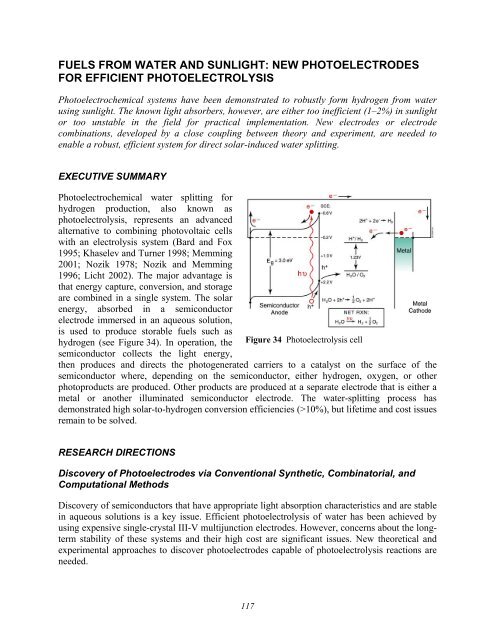Basic Research Needs for Solar Energy Utilization - Office of ...
Basic Research Needs for Solar Energy Utilization - Office of ...
Basic Research Needs for Solar Energy Utilization - Office of ...
Create successful ePaper yourself
Turn your PDF publications into a flip-book with our unique Google optimized e-Paper software.
FUELS FROM WATER AND SUNLIGHT: NEW PHOTOELECTRODES<br />
FOR EFFICIENT PHOTOELECTROLYSIS<br />
Photoelectrochemical systems have been demonstrated to robustly <strong>for</strong>m hydrogen from water<br />
using sunlight. The known light absorbers, however, are either too inefficient (1–2%) in sunlight<br />
or too unstable in the field <strong>for</strong> practical implementation. New electrodes or electrode<br />
combinations, developed by a close coupling between theory and experiment, are needed to<br />
enable a robust, efficient system <strong>for</strong> direct solar-induced water splitting.<br />
EXECUTIVE SUMMARY<br />
Photoelectrochemical water splitting <strong>for</strong><br />
hydrogen production, also known as<br />
photoelectrolysis, represents an advanced<br />
alternative to combining photovoltaic cells<br />
with an electrolysis system (Bard and Fox<br />
1995; Khaselev and Turner 1998; Memming<br />
2001; Nozik 1978; Nozik and Memming<br />
1996; Licht 2002). The major advantage is<br />
that energy capture, conversion, and storage<br />
are combined in a single system. The solar<br />
energy, absorbed in a semiconductor<br />
electrode immersed in an aqueous solution,<br />
is used to produce storable fuels such as<br />
hydrogen (see Figure 34). In operation, the Figure 34 Photoelectrolysis cell<br />
semiconductor collects the light energy,<br />
then produces and directs the photogenerated carriers to a catalyst on the surface <strong>of</strong> the<br />
semiconductor where, depending on the semiconductor, either hydrogen, oxygen, or other<br />
photoproducts are produced. Other products are produced at a separate electrode that is either a<br />
metal or another illuminated semiconductor electrode. The water-splitting process has<br />
demonstrated high solar-to-hydrogen conversion efficiencies (>10%), but lifetime and cost issues<br />
remain to be solved.<br />
RESEARCH DIRECTIONS<br />
Discovery <strong>of</strong> Photoelectrodes via Conventional Synthetic, Combinatorial, and<br />
Computational Methods<br />
Discovery <strong>of</strong> semiconductors that have appropriate light absorption characteristics and are stable<br />
in aqueous solutions is a key issue. Efficient photoelectrolysis <strong>of</strong> water has been achieved by<br />
using expensive single-crystal III-V multijunction electrodes. However, concerns about the longterm<br />
stability <strong>of</strong> these systems and their high cost are significant issues. New theoretical and<br />
experimental approaches to discover photoelectrodes capable <strong>of</strong> photoelectrolysis reactions are<br />
needed.<br />
117
















